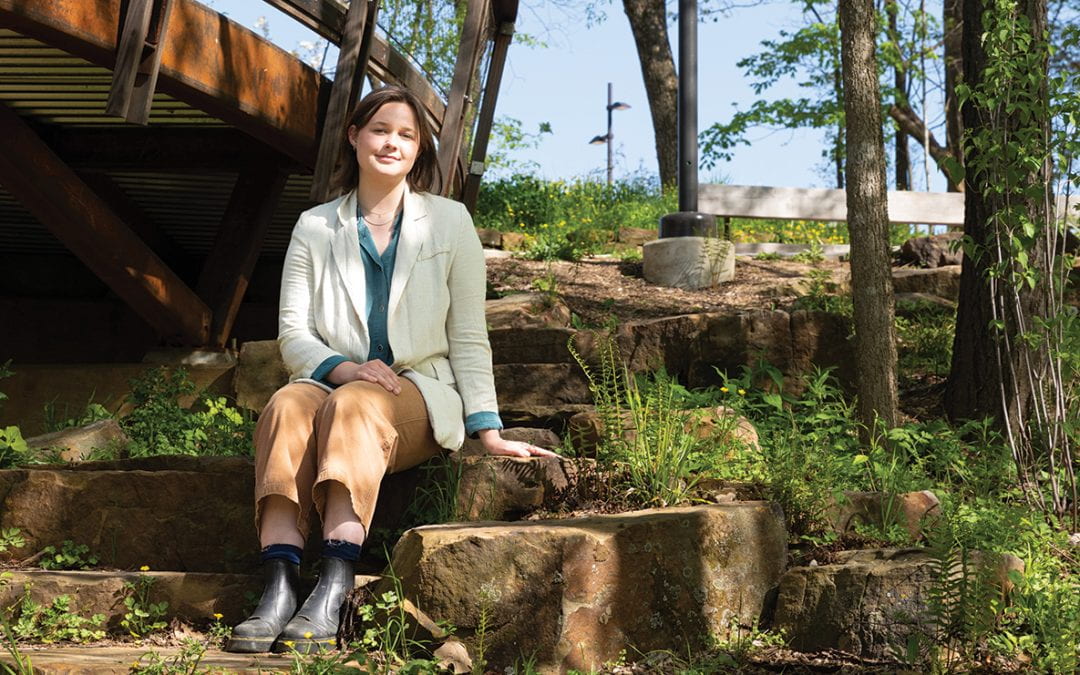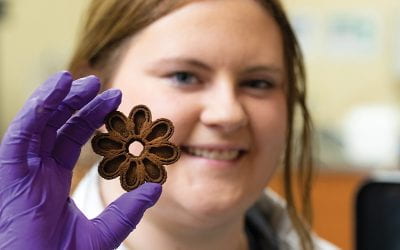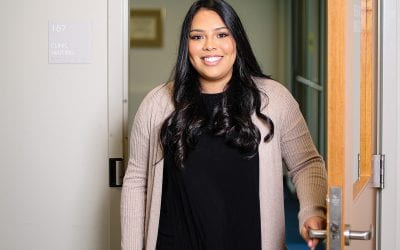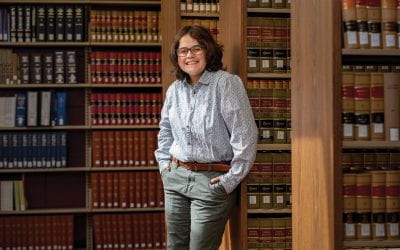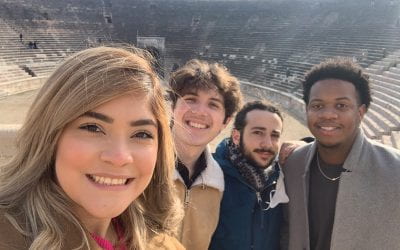
Jessica Shearman likes to walk or ride her bike on the Razorback Greenway, particularly on the section that is close to Dickson Street and the Fayetteville Public Library. There is ample street lighting, and the trail is often busy with other commuters.
The Razorback Greenway is a 40-mile, off-road, shared-use trail that connects Fayetteville, Johnson, Springdale, Lowell, Rogers, Bentonville and Bella Vista. Through a partnership between the Northwest Arkansas Planning Commission, University of Arkansas and the Walton Family Foundation, the Greenway is now the most recognized and frequently used public amenity in the area. In addition to weaving through downtowns, art projects, lakes and cultural experiences, the trail leads travelers to three hospitals, 23 schools, the U of A campus and the corporate headquarters of Walmart, J.B. Hunt Transportation and Tyson Foods.
Shearman found her way to landscape architecture and urban planning inspired by Fayetteville’s “rich community.” She grew up in Fayetteville and often explored the Greenway on her electric bike. Given its recognition and use, Shearman was interested in studying the public’s perception of safety on the Greenway and examining how that affects equitable access.
“I feel safest on that part of the Razorback Greenway, but it’s not part of the trail I live closest to,” Shearman said. That feeling prompted Shearman to ask herself, “Why do some people have easy access to certain sections of trail, but that’s not the part they use the most?”
“Northwest Arkansas has grown into a very diverse area of the country,” Shearman noted, and this diversity lends different perspectives of safety. According to the Northwest Arkansas Council Engage Report, “Between 1990 and 2010, the region’s racially and ethnically diverse populations increased from less than 5 percent in 1990 to nearly 24 percent in 2010. Since then, diversity has continued to increase. In 2021, the region was over 29 percent diverse and is expected to grow to over 32 percent by 2026.”
As the community in Fayetteville changes, Shearman believes access to public spaces must also evolve. In her study, the key to access is the public opinion of safety. Shearman defines perceived safety as “an awareness and emotional reaction to space and place based on one’s background and experiences.”
“Jessica’s honors capstone is an excellent example of a student following their curiosity along their academic journey,” said Noah Billig, Shearman’s thesis advisor, associate professor of landscape architecture and honors director for the Fay Jones School of Architecture and Design. “She has been interested in environmental safety and perceptions of safety for three years. Her final work is both sensitive and thoroughly researched, using a wide range of methods she learned as an honors landscape architecture student. Her capstone also calls for more thorough and inclusive approaches to studying our trails and other public spaces regarding safety.”
The goal of Shearman’s research is not to propose a “blanket change” to the trail system to make it safer. As active transportation corridors become more popular, Shearman hopes her research will urge city leadership and urban planners to consider perceived safety in addition to spatial factors when expanding or renovating public spaces.

Shearman used an on-site ethnographic study and assessment of representative lengths of the 40-mile Greenway, a questionnaire in both English and Spanish and geographic analysis of both results with demographic data to interpret the public’s perceived perception of safety.
“Social factors are not seen as important sometimes,” Shearman argues. “Equitable access is understanding what different communities need for accessing a space. There’s not a one-size-fits-all approach for this — continuing to further questions of study is really going to be the deliverable.”
Shearman views urban planning as a holistic framework, balancing spatial and social priorities. She urges for more multidisciplinary approaches as questions of climate change and an increasingly urban society arise. She also recognizes that her study highlights a “sometimes-contradictory nature of sustainable design” when community research is added to the equation.
“For instance, the most-used section of the trail (and assumed most perceived as safe) is closer to downtowns where there is more lighting, presence of people and minimal vegetative visible obstructions,” Shearman writes in a blog for The Field, the American Society of Landscape Architect Professional Practice Networks blog. “At the same time, the closest trail access to where I live has minimal lighting, and a presence of screening understory, despite the residential location. Based on my background and experiences as a woman, these qualities have a significant bearing on my perception of safety, and my appraisal of use options.”
As the Razorback Greenway connects the city, Shearman hopes her work will help connect everyone, regardless of gender, race, sexuality, age, abilities and resources, to these important public spaces. She’s optimistic, especially in Fayetteville.
“In Fayetteville, there’s a big proponent for making sure the community has a voice,” Shearman said.
To continue her passion for urban planning and share her experience from Northwest Arkansas internationally, Shearman is moving to Birmingham, United Kingdom, to work as a graduate urban designer at Define, a local design firm.

Using an ethnographic study, questionnaire and geographic analysis, Shearman set out to answer three questions:
- How is the Razorback Greenway perceived by the public currently?
- How do these perceptions affect the equitable access and use of public trails or active transportation facilities?
- What on-site characteristics of the Greenway lead to a perception of safety or unsafety to access?

More Field Notes
Reducing Waste by Upcycling Misfit Produce
Taylor Clary freeze dries carrots and broccoli donated from local farms to create the mixture, which is extruded from the 3D printer and then baked in an oven to reimagine the produce as a crunchy snack with a longer shelf life. By CD Eskilson / Photos by Russell...
A Loss of Words
Karina Escobar is continuing her education in communication sciences and disorders and begins her master’s program this fall at the U of A. By Shelby Gill / Photos by Xavier Smith Karina Escobar discovered her college major on her 16th birthday, but that wasn’t the...
Service-Oriented Software
By CD Eskilson / Photos by Russell Cothren A 2022 report from the Governor’s Food Desert Working Group found that over 20 percent of Arkansas households reported facing some form of food insecurity, exceeding the national average of around 10 percent. Additionally,...
Expanding Equality with Human Rights Frameworks
Expanding Equality with Human Rights Frameworks By CD Eskilson Photos by Russell Cothren In the past decade, countries in Latin America have gained international recognition for working to expand LGBTQ+ rights. From Mexico to Argentina, new laws have passed to...
Pasta and a Broadening World View
Nayeli Ortiz doesn’t like pasta, but that didn’t stop her from studying abroad for an entire semester in Italy. “Funny story,” Ortiz laughs. “I don’t like pasta. I told myself to be open to new experiences, and every day, I would eat pasta.” While on campus, Ortiz...

Using an ethnographic study, questionnaire and geographic analysis, Shearman set out to answer three questions:
- How is the Razorback Greenway perceived by the public currently?
- How do these perceptions affect the equitable access and use of public trails or active transportation facilities?
- What on-site characteristics of the Greenway lead to a perception of safety or unsafety to access?

“Equitable access is understanding what different communities need for accessing a space. There’s not a one-size-fits-all approach for this.”

